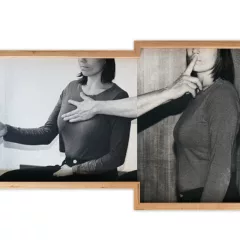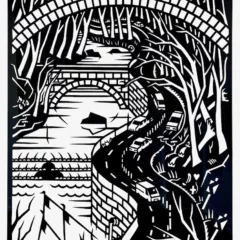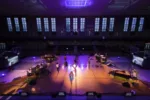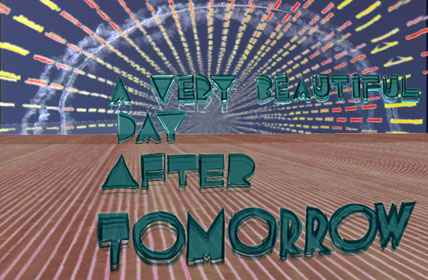 a frame from Luca Buvoli video
a frame from Luca Buvoli videoLuca Buvoli’s ramp project at the Institute of Contemporary Art sent me along a train of thought that affected the way I viewed the rest of the exhibit.
Buvoli’s ramp, A Very Beautiful Day after Tomorrow (Un Bellissimo Dopodomani), is super talky with lots of talky video and Pop plastic lettering and decorations. They add up to noise that explain and pull attention away from the not-so-talky central video, a charming melange of historical footage and animation that brings back imagery from World War II, and takes the fangs out of Italian Fascist Futurism at the same time that it celebrates it. Buvoli is entranced by flying and way that Futurism pulls its imagery from the concept of flying and action. The boyish enchantment carries the movie along, even as it begins the question the underlying values.
Coincidentally, I heard a talk (that I could barely follow) about the international use of kitsch in Worlds Fair pavilions in the U.S. and Paris during the same pre-WWII period. The talk at the “Usable Pasts” conference at Penn, was by Sarah Wilson of the Courtauld Institute of Art, and her talk was called “Avante-Garde and Kitsch? Realism, Socialist Realism and the Paris-New York Axis, 1930-1939.” Wilson was pointing up the inconsistency in Clement Greenberg’s dismissal of kitsch at the same time that he accepted Soviet Socialist Realism. I was out of my depth here, not being an academic sort of person, but on reflection I took this as a feminist attack on Modernism as defined by Greenberg. But what interested me, having just spent some time with Buvoli, was the Soviet architecture, and its projection of action and progress by the Soviet political state.
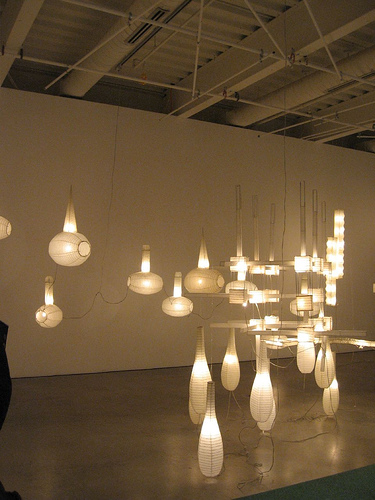
Carlos Garaicoa’s floating city of paper
But back at the ICA, Cuban artist Carlos Garaicoa’s pieces were all about architecture and politics. The lovely floating city made from Ikea/Japanese lampshade material is a sci-fi dream world, antithetical to the sad state of the world as we know it–and specifically antithetical to Havana in ruins. His large photos show where buildings have fallen down in Havana. He reconstructs on the photos with thread outlines that cast dimensional shadows. The buildings on a giant chessboard create an urban melange of old and new and future. Garaicoa’s beautiful work, while architectural, is really about politics and its failures.
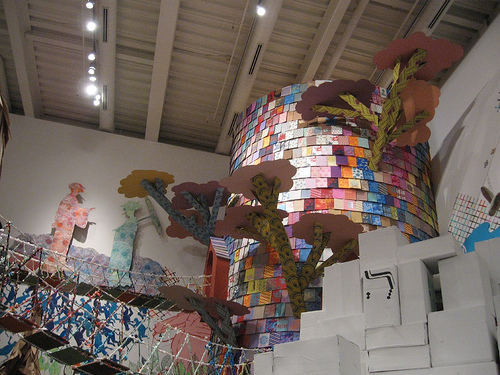
a detail of Space 1026’s storybook medieval city
Primed by these two artists struggling with political failure, I couldn’t help but look at the work by LURE, Space 1026, and even the geodesic tent of Fritz Haeg’s Sundown Schoolhouse with an eye toward politics and architecture as meaning. What I saw were young people under stress. LURE’s rooftop tent is survivalist, an attempt to find ways to live in a world that’s making itself sick with pollution; the geodesic tent is a complete rejection of the city and its spaces as a viable place for life; and Space 1026 is making storybook architecture that sends us back to a romanticized version of medieval times, a complete escape from the world as we know it. Even Matt Bakkom’s Dependence Hall, an open structure with grow lights to raise little trees, is a political and architectural statement about the failure of our society.

LURE’s hydroponic lettuce farm, inside the tent
Whether looking backward or looking forward, the message is it’s not only the Communists and the Fascists who failed to live up to their own propaganda. It’s us. I hope the politicians are listening, but somehow I doubt it.



